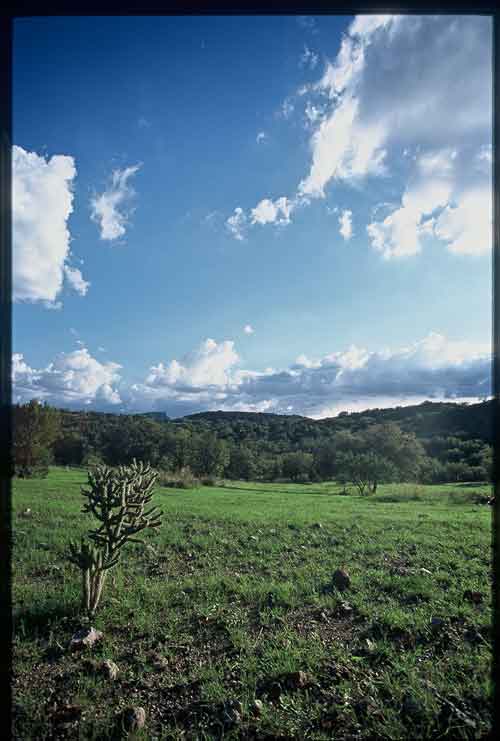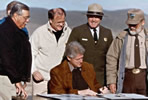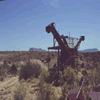 |
Wilderness 101: The Nuts and Bolts of Conservation
 
What is Wilderness?
The
Wilderness Act of 1964 created the National Wilderness Preservation
System to allow Congress to designate certain public lands as wilderness
areas "for preservation and protection in their natural condition."
And so

The Tumacacori Highlands are one of the last
roadless, truly wild corners of Arizona.
Photo: Sky Island Alliance.
that
these lands "shall be administered for the use and enjoyment of
the American people in such manner as will leave them unimpaired for
future use and enjoyment as wilderness..." Wilderness is
the highest level of protection for federal public land available in
the United States. There are 643 congressionally designated
wilderness areas in the United States today. A little more than 4% of
the continental United States is protected as Wilderness.
What is a Wilderness Study Area?
A
Wilderness Study Area (WSA) is designated to allow an area to be studied
and considered by Congress for possible designation as wilderness. WSAs
are to be managed in a manner so as not to impair their suitability—or
their “untrammeled” nature—for preservation as wilderness. WSAs may
eventually gain true wilderness status, or they may eventually be denied
wilderness protection.
How is Wilderness established?

President Lyndon B. Johnson signs the Wilderness
Act of 1964. Photo courtesy of the National Park
Service Archives, Harper's Ferry.
Wilderness
is designated from America's public lands -- land already set aside
as national parks, national wildlife refuges, national forests, and
lands managed by the Bureau of Land Management (BLM). It is created
by specific acts of Congress designating particular areas as wilderness.
Today, there are more than 105 million acres of wilderness protected
in national forests, wildlife refuges, parks, and BLM lands. Nearly
two-thirds of this designated wilderness is in Alaska.
How "natural" must the land be to qualify as Wilderness?
 An
area is considered to be natural if the imprints of human intrusion
are "substantially unnoticeable". The Wilderness Act specifically
permits trails, bridges, fire towers, pit toilets, fire rings, fish
habitat enhancement facilities, fencing, and research monitoring devices.
Other human impacts are permitted in wilderness areas, so long as their
overall impact is substantially unnoticeable. An
area is considered to be natural if the imprints of human intrusion
are "substantially unnoticeable". The Wilderness Act specifically
permits trails, bridges, fire towers, pit toilets, fire rings, fish
habitat enhancement facilities, fencing, and research monitoring devices.
Other human impacts are permitted in wilderness areas, so long as their
overall impact is substantially unnoticeable.
What activities are allowed in a wilderness area?
 Non-motorized
recreation including horseback riding, herb gathering, hiking, camping,
fishing, and hunting are allowed. Agencies may maintain and construct
trails in wilderness. The use of wheelchairs, including motorized handicapped
equipment, is permitted in wilderness areas when the wheelchair is a
medical necessity. Grazing is allowed to continue at levels consistent
with sound resource management if it existed prior to the designation
of the area as a wilderness. Non-motorized
recreation including horseback riding, herb gathering, hiking, camping,
fishing, and hunting are allowed. Agencies may maintain and construct
trails in wilderness. The use of wheelchairs, including motorized handicapped
equipment, is permitted in wilderness areas when the wheelchair is a
medical necessity. Grazing is allowed to continue at levels consistent
with sound resource management if it existed prior to the designation
of the area as a wilderness.
What activities are not allowed in wilderness?
The
Wilderness Act prohibits such activities as mining, chaining, water
development, and timber harvest (although mining may occur where there
is  a
valid pre-existing right to mine). The Wilderness Act also prohibits
use of motorized vehicles in wilderness except under emergency circumstances.
This means that chain saws, trucks, cars, bulldozers, off-road vehicles,
helicopters, and other motorized equipment cannot be used within wilderness
areas. Mountain bikes are not permitted in wilderness areas. a
valid pre-existing right to mine). The Wilderness Act also prohibits
use of motorized vehicles in wilderness except under emergency circumstances.
This means that chain saws, trucks, cars, bulldozers, off-road vehicles,
helicopters, and other motorized equipment cannot be used within wilderness
areas. Mountain bikes are not permitted in wilderness areas.
What's the difference between a wilderness and a national
park?
Wilderness areas are defined as roadless areas on public lands that
have been designated by Congress to be preserved in a primitive condition.
Parts of many national parks are also preserved in a highly natural
condition in which roads, mechanical devices, and permanent structures
are not allowed. While national parks can also include developed, roaded
areas—wilderness areas do NOT. With few exceptions, grazing and hunting
are not allowed in parks, whereas they are allowed in wilderness areas.
Why not use some other form of protection for wilderness?

A
wilderness area is protected by law (the 1964 Wilderness Act) and the
status can only be changed by an act of Congress. Congress has carefully
defined wilderness, established a uniform national system of wilderness,
and given clear guidance as to how wilderness must be managed. Other
designations such as primitive areas give temporary protection but the
protection can be modified or removed by the signature of an appointed
administrative official. Other categories, such as conservation areas
and recreation areas lack the statutory foundation of the Wilderness
Act to guide their permanence and integrity.
What about private and state land and mining leases in proposed
wilderness areas?
 Extractive
uses that existed before wilderness designation, including valid mining
claims and oil leases, are allowed to continue until either they expire,
are purchased by the government, or are abandoned by the owner. Existing
dams, developed springs, pipelines, and other water projects are allowed
indefinitely. Reasonable access to state lands and private property,
by such means as motorized vehicles, is allowed within wilderness, but
the land management agency generally attempts to acquire these inholdings
on a willing-seller basis. Extractive
uses that existed before wilderness designation, including valid mining
claims and oil leases, are allowed to continue until either they expire,
are purchased by the government, or are abandoned by the owner. Existing
dams, developed springs, pipelines, and other water projects are allowed
indefinitely. Reasonable access to state lands and private property,
by such means as motorized vehicles, is allowed within wilderness, but
the land management agency generally attempts to acquire these inholdings
on a willing-seller basis.
|
 |
 |




 Non-motorized
recreation including horseback riding, herb gathering, hiking, camping,
fishing, and hunting are allowed. Agencies may maintain and construct
trails in wilderness. The use of wheelchairs, including motorized handicapped
equipment, is permitted in wilderness areas when the wheelchair is a
medical necessity. Grazing is allowed to continue at levels consistent
with sound resource management if it existed prior to the designation
of the area as a wilderness.
Non-motorized
recreation including horseback riding, herb gathering, hiking, camping,
fishing, and hunting are allowed. Agencies may maintain and construct
trails in wilderness. The use of wheelchairs, including motorized handicapped
equipment, is permitted in wilderness areas when the wheelchair is a
medical necessity. Grazing is allowed to continue at levels consistent
with sound resource management if it existed prior to the designation
of the area as a wilderness.  a
valid pre-existing right to mine). The Wilderness Act also prohibits
use of motorized vehicles in wilderness except under emergency circumstances.
This means that chain saws, trucks, cars, bulldozers, off-road vehicles,
helicopters, and other motorized equipment cannot be used within wilderness
areas. Mountain bikes are not permitted in wilderness areas.
a
valid pre-existing right to mine). The Wilderness Act also prohibits
use of motorized vehicles in wilderness except under emergency circumstances.
This means that chain saws, trucks, cars, bulldozers, off-road vehicles,
helicopters, and other motorized equipment cannot be used within wilderness
areas. Mountain bikes are not permitted in wilderness areas. 
 Extractive
uses that existed before wilderness designation, including valid mining
claims and oil leases, are allowed to continue until either they expire,
are purchased by the government, or are abandoned by the owner. Existing
dams, developed springs, pipelines, and other water projects are allowed
indefinitely. Reasonable access to state lands and private property,
by such means as motorized vehicles, is allowed within wilderness, but
the land management agency generally attempts to acquire these inholdings
on a willing-seller basis.
Extractive
uses that existed before wilderness designation, including valid mining
claims and oil leases, are allowed to continue until either they expire,
are purchased by the government, or are abandoned by the owner. Existing
dams, developed springs, pipelines, and other water projects are allowed
indefinitely. Reasonable access to state lands and private property,
by such means as motorized vehicles, is allowed within wilderness, but
the land management agency generally attempts to acquire these inholdings
on a willing-seller basis. 
 In
Arizona, winter is the time to get outside, take the dog or kids, and explore
some of our glorious natural areas! Find your favorite wilderness area. Trek
an untrekked trail. And share with others what you find. Take a look at our
upcoming list of inventory trips, meetings, workshops, and other wildly fun
events.
In
Arizona, winter is the time to get outside, take the dog or kids, and explore
some of our glorious natural areas! Find your favorite wilderness area. Trek
an untrekked trail. And share with others what you find. Take a look at our
upcoming list of inventory trips, meetings, workshops, and other wildly fun
events. 

